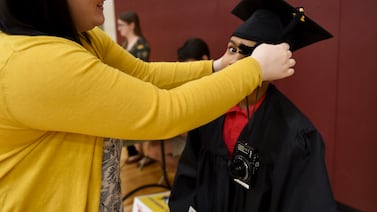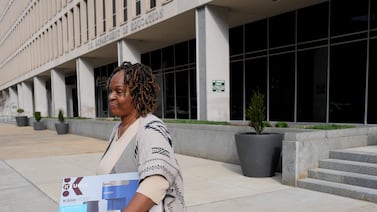DeJernet Farder braced for academic fallout from the pandemic as she welcomed her new class of first-graders at Morton School of Excellence on Chicago’s West Side this fall.
Many youngsters had tuned out remote instruction by the previous spring — despite the banana suit and pizza hat Farder donned to grab their attention on screen. Now back to learning in person full-time, Farder set aside extra time to gauge how well students knew their letters, sounds, and other early reading basics.
The results galvanized her: Many of her students were missing skills they would normally master halfway through kindergarten.
Across the city, educators such as Farder have worked to size up the pandemic’s impact on learning, using tests, quick check-ins, and classroom observation.
But the district itself has no panoramic picture of what the damage is. Over the summer, it discontinued its contract with the nonprofit NWEA to provide the Measure of Academic Progress, or MAP, a math and reading test once mandatory for all campuses.
Instead, just as schools tackled bouncing back from pandemic disruption, the district started phasing in two new suites of optional assessments.
Some school leaders say the district failed to make a plan for taking the measure of where students are academically across the board. They argue a fuller picture of proficiency might help the district invest millions in federal dollars for academic recovery more strategically — and track whether those investments are paying off. Unveiling new tests amid the outbreak has made it harder to interpret scores and put them into context for parents, who are eager for clues on how children weathered the crisis academically.
But other educators say migrating to tests that do a much better job than the MAP of giving teachers information to tailor classroom instruction is crucial. And they caution that rushing to test students before they readjust to school routines and work through the pandemic’s traumas would not produce reliable outcomes.
“We already know that learning suffered tremendously last year,” said Scott Marion, the executive director of the nonprofit Center for Assessment, which consults with the district on testing. “The question is what do you do about it?”
Caught between these two arguments is Pedro Martinez, the district’s new CEO, who told Chalkbeat earlier this fall that he was grappling with the lack of consistent assessments across campuses. Pressed by school board members last month on how the district will know if its two-year pandemic recovery plan was working, he vowed to present the board with some baseline academic data in the next couple of months.
It’s not clear exactly what this data will be. The district provided a statement for this article but declined an interview with a district official or a principal.
Districts across the country are approaching the task of academic recovery in dramatically different ways, in part because the federal government did not attach accountability requirements and gave limited guidance on spending the billions it passed on to schools for that task.
Some districts in Illinois and elsewhere made plans to track the outcomes of their federal stimulus investment closely using student assessments. On the flip side, plans to test students extensively — New York City, for one, is deploying a battery of screening tests at a cost of $36 million — have drawn criticism from parents and educators who say students’ mental health needs should come first.
A testing shift
Back in Chicago, Farder and fellow educators at Morton School of Excellence considered over the summer whether they should transition to the new assessments the district was embracing: a suite of screening and diagnostic tests called Star 360 by Illinois-based Renaissance, on the one hand, and assessments embedded in the new universal Skyline curriculum Chicago rolled out this summer, on the other. In recent years, the district’s teachers union contract has given educators more power to decide what tests students take and when.
At Morton, teachers felt there was just not enough time to make the transition to the new tests. Farder stuck with an optional reading comprehension and phonics assessments called TRC/DIBELS, which helped her begin to measure the extent of the academic fallout and make a plan.
Still, she wanted more information. She gave an extra test on letter sounds: a one-on-one assessment that took her about a week.
Only three students in her class of 24 knew the sound the letter “u” makes. Only one knew all the letters and sounds.
“I’ve tested students more this fall than I ever have,” Farder said, “but it’s testing to guide classroom instruction.”
It’s hard to say how academic needs compare among campuses or how Chicago students fared compared to peers elsewhere in the country. Some recent national studies have used MAP scores in trying to quantify how the pandemic set students back academically, showing it hit low-income, Black and Latino students the hardest.
But officials and school board members said this past summer that the MAP, designed to measure student growth, had become too tied up in a punitive system of evaluating educators and rating schools. The district has not yet said what tests, if any, it will use for evaluations post-MAP. The school board approved a new no-bid agreement with Marion’s organization last month to help design and pilot a new school performance ratings system to replace its controversial model known as SQRP.
The assessments, which the district suspended during the pandemic, also were not connected enough to schools’ curriculums and to state learning standards to offer real-time, useful information to guide instruction, those officials said.
In fact, a report by Paul Zavitkovsky at the Center for Urban Leadership at the University of Illinois Chicago released earlier this fall argued that the pressure to teach to those tests might have contributed to slowing student growth, particularly in reading.
In its statement, the district said it “strongly” encouraged schools to screen all students in grades three and higher in reading and math using the Star 360 assessments. More than 80% of schools opted into either the Star 360 math or reading tests, with most offering both. This is the first time these types of tests are available in Spanish, the district noted, and the first time high schools have access to universal screeners.
Martinez said in an interview with Chalkbeat shortly after taking over the district that he was trying to figure out how to navigate the lack of a consistent assessment across campuses. He said providing parents with easy-to-digest information on where their children stand is important.
“It’s not about whether you’re a fan of standardized testing or not,” he said. “Because in Texas they did testing, academic plans this fall were personalized for each child. Programs were customized to the children who struggled the most.”
At his first school board meeting in late October, Martinez decried the dearth of data from the past two years, but he said campuses were hard at work assessing students’ academic needs. He said the real-time information on where students stand that teachers glean in the course of instruction is often the most accurate measure.
And he said schools are already clamoring for more resources for academic supports, with school leaders arguing the district should spend now more of the federal stimulus dollars meant to be doled out over three years. His initial impressions are that some campuses are prepared to intervene and speed up learning to get more students caught up.
“And then,” he said, “there are some schools that are struggling.”
Breaking with the MAP
One Chicago elementary school principal, who spoke with Chalkbeat on the condition of anonymity, blasted the district’s decision to administer the state Illinois Assessment of Readiness last spring instead of this fall, an option the state gave districts because of last spring’s disruption.
Illinois recently released statewide results on that test showing double-digit dips in the portion of students who met math and reading standards, though it’s holding off on disclosing district-level scores until mid-December. In Illinois, fewer than half of students took the in-person-only tests; most were likely those who opted for hybrid learning in the spring, who were disproportionately white.
Many more students would have taken the test this fall, offering a window into where children struggled the most academically, the Chicago principal said, calling it a “big missed opportunity.”
He also decried the timing of the district testing shift, as principals and educators already have full plates navigating the ongoing pandemic. Districtwide information on academic needs from the MAP could have helped the district more wisely deploy federal stimulus dollars for academic recovery. (The district has said it factored in student demographics and the greater toll COVID took in some neighborhoods to steer more recovery money to needier schools.)
He also said sharing MAP results with families mid-fall used to “light a fire under a lot of kids and parents,” triggering important conversations about how better to support learning at home. Many educators at his school administered Star 360 tests this fall, but the school is not sharing scores with parents because they don’t feel they can put them into context or answer questions about them.
“It was a terrible decision to drop that test during the pandemic,” that principal said.
But Marion, the expert from Center for Assessment, says getting a detailed districtwide accounting of academic damage is less important than giving schools and individual educators the right tools to tailor classroom instruction. He said because it was largely divorced from curriculums, the MAP did not give teachers enough information they could use to address any gaps the tests might reveal.
Marion said the main advantage of the Star 360 tests is that they take less time. But he says the Skyline assessments his organization helped create represent a shift toward what experts call “instruction-sensitive” tests, ones that are closely tied to what students are learning and allow teachers to adapt instruction based on their needs.
The district has not said how many schools have adopted parts of the new curriculum — or the tests that go along with it. But Marion said the district was right to encourage gradual voluntary adoption.
Meredith Kroot, the mother of two district students who have learning disabilities, said she is not particularly interested in districtwide baseline scores, which often obscure the challenges different student groups face. But she says parents like her are hungry for clear information on where their children stand academically this fall.
Her son, an eighth-grader at Bell Elementary on the city’s North Side, struggled to engage with remote learning during the pandemic, and his grades plummeted. They have improved somewhat this fall, but teachers have also signalled they are giving students more grace amid the ongoing upheaval.
Kroot received one-page Star 360 reports on the math and literacy assessments her son took. But she struggled to interpret the numbers or put them into context.
“I feel so lost,” she said. “I have no idea where he is and what he’s missing. Nobody is giving us a plan about how to recover academically.”
Tackling the pandemic fallout
At Morton School of Excellence, Farder and her colleagues sprang to action to address students’ heightened academic needs.
To get all students up to speed on recognizing letters and sounds at the start of the school year, Farder made flashcards with lanyards that students wore around their necks in class.
She also sent flashcards home and encouraged parents to practice with their children.
Setting aside half of her school day for small group learning has been crucial to deal with student reading levels that diverged widely during last year’s pandemic disruption. She has offered students who are reading at grade level more challenging work — while working to speed up learning for their peers.
“Accelerated learning means hardcore differentiation with a lot of data,” she said. “You can ebb and flow so all students get what they need.”
Experts say timing assessments properly — after students had settled in and eased back into the routines of in-person learning — was important this fall. In Chicago and across the country, educators say that readjustment remains a work in progress.
“The worst thing you can do is bring kids back and sit them down for a test,” Marion said. “It’s cruel and unusual punishment, and you won’t get good data.”
Barbara McKeon, a former principal and senior program director of the Cahn Fellows Program, which works with principals in Chicago and other urban districts to develop their leadership skills, agrees.
“There’s no value in the assessment information if the child is not available for the test socially and emotionally,” she said.
McKeon says assessing students’ academic needs is a focus for many of the programs’ latest class of fellows, including Chicago Public Schools principals. Many school leaders have been intensely focused on COVID safety measures earlier in the school year, while also striving to ensure that students readapt to the structure of in-person school and relearn its routines.
Farder, the Morton teacher, says she has continued to track student progress with quick daily checks of what students have learned. Much work remains, but she is encouraged by the headway her students have made. The number of students who know all their letters and sounds has swelled to 11.
Each time a new student hits that milestone, she announces it to the class to raucous cheers and applause. Those students get a Baby Yoda sticker, which other teachers and staff will point out and praise in the hallways. And they get to be “mini-teachers,” helping quiz their peers.
“Last year was not fun teaching,” she said. “This is fun again. As hard as it is, it’s really worth it.”







